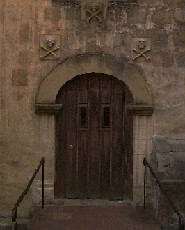

The only problem with their plans was the lack of labor. With no Spanish people in the area, there would be no one to work on the farms. They soon solved that problem, however, by turning the farms into missions. The missions would be led by Fathers who would pursue the Catholic calling of converting non-believers into Christians. Their converts, the Native Americans, would also work on the missions. This decision solved both problems for the religious Spaniards, but was just the beginning of the problems for the Native Americans.
The missions were designed by the padres, and actually built by the
Native Americans they hoped to convert. Each mission was unique in a few
ways, but they all had the same basic plan: a large, four-sided building
with a patio in the center. The church was usually placed in one corner
of the square; it was always the tallest and grandest
building. All the rooms in the square building faced the patio. The
back was reserved for the unmarried native women who worked in the kitchen.
The other three sides contained the rooms for the two priests of the mission,
workshops, a kitchen, storage rooms for food, and the mission office. The
rest of the Native Americans lived outside the mission walls in huts. Surrounding
the mission was vast fields used for growing crops and feeding livestock.
The actual labor of the missions fell to the Native Americans.
Because they practiced a polytheistic religion, did not speak Spanish,
had dark skin and a very different way of life, the natives were viewed
as heathens; their way of life was considered inferior to the that of the
Spaniards. Because of this the Spanish made it clear that working on the
missions was not optional. The locations of the missions were all very
planned and very deliberate.
Each mission was placed one day's ride or hard walk from its nearest
neighbors. This made it easier for the Spaniards to trade and sell their
food and crafts as well as to share information. They were also very careful
to place all the missions near the sea so that ships would have plenty
of opportunities to get fresh supplies before heading out to sea.
Many of the missions were placed along Native American trails. The reasons for this were simple: The Spanish knew that the Native Americans always made their trails near fresh water and fertile soil; two things that the Spanish needed for successful missions. Another reason for the choice of native trails was the fact that it would make recruiting people even easier.